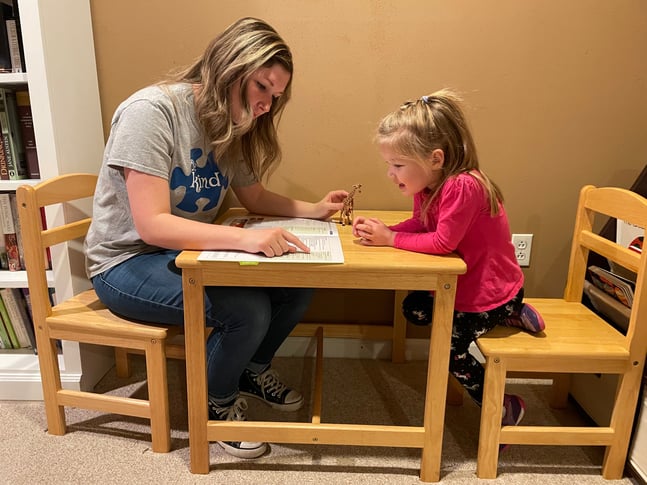Helping Your Autistic* Child Develop Emotional Intelligence
Children with autism are often lacking in the area of emotional intelligence. The good news is that scientists now better understand the biological reasons behind why autistic individuals face challenges in this area. By understanding the science, and understanding that emotional intelligence skills can be learned, we can use specific strategies to help autistic children develop and strengthen social and emotional skills.
What is Emotional Intelligence?
The idea of emotional intelligence first began in the 1960s and is described as the ability to comprehend, perceive, utilize, manage, and cope with feelings. Emotional intelligence, or EI, was portrayed by author Daniel Goleman as:
“Understanding and managing your own emotions and influencing the emotions of others.”
Goleman proposed that even though individuals were born with a general level of EI, this is a skill set that can be developed and learned throughout one’s lifetime. He discusses EI as being proficient in competencies that include self-regulation, social skills, and empathy. Other psychologists, such as Abraham Maslow and Howard Gardner studied similar concepts of emotional strength and multiple intelligences in individuals. Many who have studied EI believe there is a direct link between having higher levels of EI and success, especially in the workplace.
It was first in 1908 that Eugene Bueler coined the word “autism” to describe a patient of his who had withdrawn from the world around him. The term autism itself comes from the Greek word “'autós'' which is interpreted as withdrawal within self. Later, autism became part of the Diagnostic and Statistical Manual of Mental Disorders (DSM) and it is diagnosed by having deficits in the criteria of social-emotional reciprocity as well as other characteristics. Since autism sometimes results in deficits in connecting with others, how can we foster and improve this behavior with our children on the spectrum and help them form relationships with others? How can we help provide enrichment opportunities that help them develop in the area of social reciprocity when we know this often does not come easily?
The ideal is to help children become internally motivated to create and foster relationships with those around them. Supporting children and helping them develop motivation to connect to others, and not overly focus on a goal or the outcome of an interaction but actually enjoy the experience of connection, can help children form better and stronger relationships with others.
Understanding the Biology
If we better understand the biology and some of the reasons behind the lack of development in EI for children with ASD that will help. Let’s start with mirror neurons. First of all, what are mirror neurons? Mirror neurons are a type of brain cell that respond equally when we perform an action and when we witness someone else perform the same action. Mirror neurons not only help us to form our own behaviors, but they also help us to observe and interpret the actions of those around us. Some scientists even believe that these neurons form the basis for their social behavior, language acquisition, capability to imitate others, and the ability to show empathy. This is, in fact, the essence of social-emotional reciprocity.
Over the last ten years, even more research has been tied to mirror neurons that can help explain an individual’s level of empathy, or lack of empathy, for others. When the mirror neurons are not operating effectively this results in behavioral and social deficits like in the case of autistic people. Research by Théoret and Tager-Flusberg and their colleagues found that “when autistic people watch the hand movements of other people, their brains' mirror-neuron areas activate less than the mirror-neuron areas in neurotypical adults' brains.”
The important question in all this biology is whether mirror neurons are something that we can generate through learned associations or are simply part of our genetic composition. Many learning theorists believe that yes, they can be something that is developed and not solely based on whether we were born with them.
Research suggests that mirror neurons are trained and developed through ideas such as associative learning, which is extremely similar to techniques such as applied behavior analysis (ABA) therapy, often a preferred treatment for those with autism. They believe that as we practice and develop new skill sets in the areas of emotional intelligence, we can actually increase the production of mirror neurons in our brains. This is exciting news! If this is confirmed by further research it means we can teach and reinforce this behavior and improve the individual’s level of EI, while helping to increase the mirror neurons in their brain! Nurture (environment) helps to improve nature (biology.)

So How Can We Develop Improved EI in Our Autistic Children?
Now that we know the biology behind it all, let's talk about ideas and resources to help teach EI. Those on the spectrum tend to have more black-and-white thinking patterns. They think better in concrete terms rather than abstract ideas. In relation to emotions (an abstract concept) we can start to teach them in a more tangible manner. By helping them learn what facial expressions mean when it comes to emotions, we help them connect a visual with a feeling. This helps them to label their feelings and also start to build empathy and understanding, increasing their levels of EI.
1. Use Emotion Cards to Teach Emotions
Stages Learning Language Builder Emotion Cards can be used to help children learn emotions by looking at faces showing different expressions and identifying the emotion typically connected with that expression. Children develop this as a skill and it may be possible that they are also developing mirror neurons in the brain. You can start teaching your child how to identify emotions today by using our free download of Stages Learning Language Builder Emotion Cards.
2. Label Feelings When a Child is Experiencing a Specific Emotion
Other strategies to help increase levels of EI can include labeling feelings when children are experiencing that emotion. For instance, if a child loses a toy, you can verbalize this feeling to them and connect it to a time someone else may have felt that way:
“You are sad that you lost your game. I was sad when I lost my phone this morning. When you are sad, sometimes you might feel like you want to cry, need a hug, or need some alone time to start to feel better again. What do you need to feel better?”

3. Use Social Narratives to Teach Social and EI Skills
Social narratives (sometimes called Social StoriesTM) are also a great way to encourage and teach expected behaviors, like keeping hands and feet to yourself, in a way that children with autism can understand. Learning these types of socially appropriate behaviors increases positive relationships with the peers around them and this can in turn help them to internally feel motivated to continue other prosocial actions.
4. Remember: Patience and Consistency are Key
Just like Rome was not built in a day, developing empathetic behaviors and emotional intelligence will also take time. These new skills need to be taught with fidelity and consistency to individuals with autism in order to help it become an innate action. Much like we see a red light when driving and automatically put our foot on the brake, individuals with autism can learn to see others’ emotions and respond in a socially appropriate manner with more automaticity, both increasing levels of EI and strengthening relationships with those around them.
STAGES® Learning has created an early autism curriculum called Language Builder: Academic Readiness Intervention System (ARIS) that includes teaching children with autism EI and social-emotional learning skills (SEL) to help autistic children thrive.

Please tell us the experiences you have had with teaching your child EI. We would love to hear from you!
We hope you enjoyed the information in this article. Stages Learning also offers free downloadable resources to support teaching and learning with individuals with autism. Start with our free Picture Noun Cards and see our collection of other downloadable resources here!
*A Note from Stages Learning: Whenever possible Stages Learning uses the preferences stated by an individual as to whether to use identity-first (“autistic person”) or person-first (“person with autism”) language. In a poll of 21,000 people, 69% preferred identity-first language, and 31% preferred person-first language. A thought piece by Northeastern University indicated that in the majority of cases, autistic people themselves prefer to be called autistic people, whereas caregivers and professionals prefer the wording “people with autism.” We agree with the Northeastern article that the group being talked about should be able to dictate what they are called. As we move forward we plan to alternate our usage in our written materials and in our speech. We recognize the importance of this issue to so many people and we plan to revisit this issue in the coming years with the expectation that preferences will likely continue to shift and we will do our best to reflect these changes. We welcome your thoughts on this issue. Please feel free to contact us.
This article was based in part on the following resources:

Katie Vena
Katie Vena is a licensed professional counselor, certified school counselor, and registered play therapist. She began working with children on the spectrum in 2004 as an ABA therapist. For the last 16 years, she has been in the school system, working with all types of exceptionalities and children! She also teaches continuing education courses in areas such as Autism and PBIS. In her free time, she loves to travel and spend time outdoors with her family.




